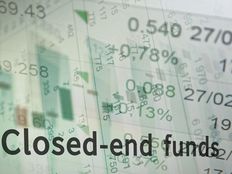
Municipal debt with investment grade ratings are generally regarded as a safer form of investment when compared to equities; going by the historical trends, municipal debt tends to have a low correlation with equity markets. Hence, municipal debt portfolios containing various municipal debt offerings have been quite attractive for conservative and high earning investors in the United States.
These portfolios can be mutual funds, exchange-traded funds (ETFs) or a simple portfolio created and managed by the investor himself/herself. These portfolios – mutual funds, ETFs and funds – have also solidified their attractiveness on the basis of risk mitigation and liquidity. However, each portfolio mix and its structure can be very different from each other and their characteristics are unique for different investors.
In this article, we will take a closer look at closed-ended funds (CEFs), their place in your portfolio and if muni bond CEFs can offer higher risk-adjusted returns than the more common muni bond ETFs or individual bonds in the current environment.
What Are Closed-Ended Funds?
A closed-ended fund (CEF) shares many of its characteristics with an open-ended mutual fund; for example, they are both comprised of a pool of investment securities based on the fund’s objectives and managed by an investment advisor with an annual expense (management fees).
Unlike ETFs, CEFs go public with a fixed number of securities and cannot be added to or subtracted from based on the market demand. In addition, the investment income – dividends – can be paid out or reinvested into the fund. On the contrary, closed-ended funds trade like stocks: CEFs are issued by setting up an investment company that goes public through an Initial Public Offering (IPO) and raises the desired, preset, capital amount. Hence, the fund is listed and trades like a stock on the stock market. Any CEF, comprised of different securities, is actively priced throughout the day based on supply and demand, like stocks, where an open-ended fund – mutual fund – is priced at the end of the day.
Closed-ended funds also differ on their pricing from open-ended funds. CFEs are often traded at discounts or premiums from their Net Asset Value (NAV). The NAV is calculated regularly, but price depends upon the supply and demand of these instruments, which can be very different from the actual NAV of the underlying securities. Unlike CEF, open-ended fund pricings and valuations are representative of the NAVs of its underlying securities, which are priced at the end of the business day.
How Do ETFs Differ From CEFs?
Exchange-traded funds have been quite popular and have given mutual funds a run for their money, literally. In recent times, there have been major capital outflows from mutual funds to ETFs for their lower fees due to passive asset management. ETFs have been known to follow an index in the market like S&P 500. Their performance is strictly dependent on the underlying assets performing well and investors capitalizing on the growth. However, CEFs are actively managed to meet or exceed their performance objective while sticking with their investment strategies. In a CEF, all the underlying securities are actively traded, adding another method of generating lucrative returns on the portfolios; close oversight can also help to prevent extreme capital loss.
Let’s compare the yields and expense ratios of a CEF and an ETF: VanEck Vectors CEF Municipal Income ETF (XMPT) is a CEF and iShares National Muni Bond ETF (MUB) is an ETF.
| Ticker | AUM | 12-month Yield | Expense Ratio | Net Return |
|---|---|---|---|---|
XMPT | $100.70 million | 4.85% | 1.59% | 3.26% |
MUB | $9.7 billion | 2.22% | 0.25% | 1.97% |
How Do Closed-Ended Funds Fit Into Your Portfolio?
As mentioned earlier, CEFs actively trade on the stock market like regular stocks and their price depends on the supply and demand, which can be different from the actual valuation of their underlying securities; if a CEF is selling at discount to its NAV, then it can be a profitable opportunity for investors to capitalize and enhance their returns. Here are a few more reasons to consider investment in CEFs:
- Given the closed-end nature of CEFs’ investment portfolios, the fund manager can invest in an instrument without having to worry about sudden sell/outflow of capital by investors. This allows the fund manager to stick to his strategy without fearing redemption of capital.
- Unlike open-ended portfolios, a CEF’s performance can also be measured by its Earnings Per Share (EPS) of the portfolio and can be easily tracked over time.
- Given their closed structure and active management, CEFs can effectively use leverage and borrow additional capital to enhance their returns even more.
- The high expense ratio on CEFs can be offset by their potential ability to outperform their counterparts and, like mutual funds, CEFs are also very transparent about their underlying securities, their credit qualities and maturities to determine risk levels.
- A high number of CEFs invest in bonds and preferred stocks to increase the fund’s yield; by using this as the vehicle for investing in these asset classes, investors can sometimes avoid some of the taxes involved with holding fixed income securities.
- Above all, most of the information that’s accessible for individual stocks or their portfolios can be found on CEFs, which helps to make an informed investment decision; this includes 52-week average, EPS ratio and distribution rates.
The Bottom Line
Like many other investment vehicles, closed-ended funds have their own space in the markets that investors can capitalize on. For new investors considering CEFs, they must weigh their options.
The best measure of performance for CEFs composed of municipal debt can be their past performance/returns and the stability of local government debt. Though CEFs have the potential of providing higher yields than other investment vehicles given the active management of the closed-ended municipal debt portfolios, investors must analyze the stability of these returns and should understand the reason behind any abnormal variations year over year.
In addition, CEFs tend to have higher expense ratios that will cut into the overall tax-free returns of the portfolio. At the end, given the active management of the portfolio, investors must do their research on the fund manager and his/her track record on managing these types of investment pools.






